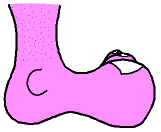An introduction to NSW State League events
Information on each event
State League events are generally pre-entry, so you need to enter a few weeks in advance. Most State League courses are usually also available to enter-on-day at each event – often they will not include the full range of hard courses. Enter on the day orienteers are not eligible for Orienteer of the Year points.
To find information on each State League event, click on the link from the State League webpage or go to the State League event via the NSW Event Calendar. Each State League Event Information page will have:
- links to an information flyer – which has detailed information about the event;
- at the bottom of the page a Google map showing where the event is being held; and
- an “Enter and/or order services” link.
What does all the information in the flyer mean?
Course
State League courses have varying levels of difficulty. Generally, new orienteers progress up the four levels of difficulty of orienteering courses: from Very Easy, via Easy and Moderate to Hard.
The distance stated for each course is the straight line distance between controls. On bush courses you should expect to cover 20-40% further than the stated distance.
People vary in how quickly they learn to orienteer. Usually the toughest jump is from moderate to hard. A fit beginner might enter the Very Easy course at a State League event and finish in 10-20 minutes. In this case, ask the organiser if you may have a map to run around the Easy course.
Terrain
Some orienteering terrains are more navigationally difficult than others. In broad terms, terrain can be described as:
- Urban terrain – eg parks, streets, university or school campus;
- Bush terrain with lots of tracks, fences or paddocks;
- Bush terrain with few tracks, lots of rock or complex contour detail.
It will be more difficult to progress up from Easy to Moderate or Moderate to Hard if the terrain is type 3 than for type 1.
Format of course
Hard level State League courses are described as:
- Sprint – winning time of 12-15 minutes. These test the orienteer’s ability to read the map, to navigate, plan and carry out route choices whilst running at running at high speed. Sprint races are often held in urban terrain.
- The Middle Distance winning time is 20-35 minutes. It takes place in the bush with an emphasis on detailed navigation and finding controls is challenging. It requires constant concentration on map reading.
- The Long distance winning time varies from 20 to 90 minutes (depending on your age and sex). Long distance courses emphasise physical endurance and route choice. The terrain will often be rougher and hillier than the other formats.
Orienteers who have not run many hard courses will often double or triple the winning time.
Class abbreviations
When you enter a State League event you need to choose a class. Your choice can be influenced by your sex, age, experience and how long you want to be out on the course.
- Sex - classes are split into men (M), women (W) and both (M/W or Open). Women may compete in men’s classes.
- Age:
- Juniors - competitors aged 20 or younger belong to each class up to the end of the calendar year in which they reach the given age. They are entitled to compete in older classes up to and including 21.
So, if you turn 13 or 14 this year you would normally run in the 14 age class. But, you could choose to run in the 16, 17-20 or 21 age classes.
- Adults and Veterans - competitors aged 21 or older belong to each class from the beginning of the calendar year in which they reach the given age. They are entitled to compete in younger classes down to and including 21.
So, if you were 42 at the beginning of this year you would normally enter the 40 age class. But, you could choose to run in the 35 or 21 age classes.
- Open – open courses can be entered by anyone.
- Experience – if you enter an A class (and it’s M16A or W16A or older) you will be on a Hard course. The B course will be a Moderate. A courses for the 10 age group are Very Easy, for 12 Easy and 14 Moderate.
- How long you want to be out on the course – AS (A short) courses are available in the 21 age category (open to all ages) and in various veteran age groups. These are Hard standard and cater to people who want a course that is shorter than the A class in their age bracket. Generally, AS entrants are not as fit or less competent navigators than A entrants.
- M/W10N – this class is designed for younger children who are not confident to go on a course alone. They can receive assistance both on the course and in studying their map before they start. Assistance can be from a parent or other mentor. Times are not recorded for M/W10N.
How to pre-enter
If you have not pre-entered an event before, you will need to:
- register yourself in Eventor. Please tick the box that says “I would like to receive information about orienteering from Orienteering Australia”. This allows orienteering to send you emails to update you about events – occasionally, this could be an email saying the event is moved, postponed or cancelled;
- login and enter the event in using the Enter and/or order services link on the Event Information page; and
- pay using the on-line credit card (PayPal).
Some first time users need assistance when using Eventor – so look at Orienteering NSW’s Frequently Asked Questions page.
Preparation for the event
You should think about:
- Do you have the appropriate gear and equipment? See Orienteering NSW’s What to bring webpage. State League events are held all over NSW, so the weather can be considerably hotter, colder or wetter than at home.
- Do you need to book accommodation? There are often State League events on more than one day of a weekend.
- Are there other orienteers who you could travel to the event with (many a romance among orienteers has blossomed this way)?
- What is your start time? This will be on the Event Information page a few days before the event.
- How long will it take to drive to the event, walk from the parking to the finish (where you can leave a bag) and then walk to the start? Again, this will be on the Event Information page a few days before the event.
- Are you familiar with orienteering’s map symbols and control symbols? If not, click on the links.
Ask questions
Orienteers love answering questions about the sport, so if in doubt, ask someone at an event.






































